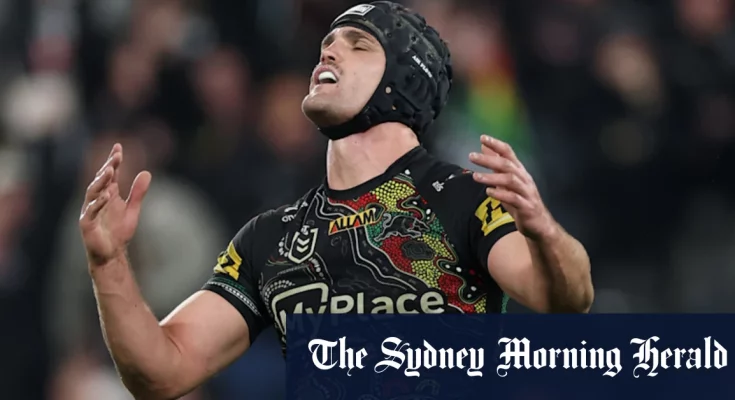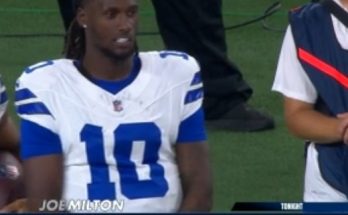The National Rugby League (NRL) has once again found itself at the center of intense debate following a contentious moment involving Melbourne Storm halfback Harry Grant. The incident, which occurred during a high-stakes clash against the Penrith Panthers, has ignited discussions across social media, clubrooms, and among fans, raising questions about gamesmanship, refereeing interpretations, and the boundaries of fair play in rugby league. The league’s decision to uphold the call, despite the Panthers’ strong objections, has only intensified the conversation, highlighting the fine line between legitimate play and tactical manipulation in professional sport.
The incident in question took place during a crucial stage of the match when the Panthers were looking to consolidate a narrow lead. Harry Grant, renowned for his astute game management and situational awareness, appeared to draw a penalty in a manner that the Panthers described as “manufactured” or “strategic.” According to the Panthers, Grant’s actions involved exaggerating contact from a defender, which they argue went beyond the spirit of fair competition. In their post-match statements, Penrith officials did not hold back, claiming that the decision impacted the momentum of the game and undermined the integrity of play.
From the NRL’s perspective, however, the decision was entirely within the rules. A spokesperson for the league emphasized that referees are trained to assess player actions based on intent, impact, and overall context. In this case, the officials concluded that Grant’s play, while clever and perhaps opportunistic, fell within the bounds of legal gameplay. The NRL’s position reflects a long-standing approach to interpreting the rules in a manner that allows skillful players to leverage every advantage available to them, provided they do not engage in overtly unsportsmanlike conduct.
This stance has provoked widespread debate among fans, analysts, and former players. Social media platforms have been flooded with clips of the incident, accompanied by heated commentary dissecting every nuance of the play. Some argue that Grant’s awareness and ability to draw penalties is a testament to his intelligence and experience on the field, demonstrating the very skills that make him one of the game’s elite playmakers. Others, however, suggest that such tactics, if left unchecked, could encourage players to prioritize clever manipulation over genuine competition, potentially eroding the credibility of the sport.
The Panthers, for their part, have expressed frustration not only at the decision itself but also at what they see as inconsistent application of rules across the league. Penrith’s coaching staff highlighted previous instances where similar plays by other teams were penalized, creating a sense of inequity. In press conferences, Panthers officials called for greater clarity and consistency in officiating standards, emphasizing the importance of ensuring that all players operate on a level playing field. This call for standardization has sparked conversations among commentators about the balance between subjective referee judgment and objective enforcement of rules, a perennial challenge in professional rugby league.
Harry Grant, typically known for his composure and professionalism, has largely refrained from publicly engaging in the controversy. Within the Storm camp, however, there is a recognition that drawing penalties is an essential part of his role as halfback, and the team has praised his ability to influence the game under pressure. Analysts note that in modern rugby league, the mental aspects of play, including reading opponents and manipulating defensive structures, are just as critical as physical prowess. Grant’s actions, from this perspective, represent a sophisticated understanding of game dynamics, rather than unsportsmanlike conduct.
The situation also sheds light on the broader culture of rugby league, where the concept of “gamesmanship” is deeply ingrained. Players are often encouraged to exploit tactical opportunities, including drawing penalties, engaging defenders in nuanced duels, and using positioning to influence referee decisions. While some of these tactics can be controversial, they are generally accepted as part of the strategic complexity of the sport. The debate surrounding Grant’s penalty highlights the tension between the competitive intelligence of players and the perception of fairness among opponents and fans.
From a historical perspective, rugby league has long grappled with incidents where player actions straddle the line between clever play and perceived gamesmanship. Iconic moments from past seasons, involving players who drew penalties or manipulated referee interpretations, have sparked debates strikingly similar to the current controversy. Each incident has forced the league, clubs, and the broader community to reflect on the values they wish to prioritize: entertainment, skill, fairness, or a combination of all three. In this context, the NRL’s decision to back the call is consistent with previous approaches that favor technical skill and game intelligence within the boundaries of the rules.
The media response to the incident has been relentless. Rugby league pundits have dissected video footage frame by frame, debating whether Grant’s movement and body positioning constituted legitimate play. Opinion pieces have ranged from praising Grant’s ingenuity to criticizing the perceived opportunism. Fan forums and comment sections have mirrored this division, with supporters of the Storm celebrating the halfback’s quick thinking and Penrith fans voicing disappointment at what they see as an unfair advantage. This polarized reaction underscores how moments of controversy can dominate narratives in professional sports, shaping perceptions of players, clubs, and officiating standards.
Analysts also note the potential long-term implications of incidents like this. For referees, each controversial call becomes a teaching moment, informing training programs and interpretations of the rules. For players, it highlights the ongoing need to balance aggression, intelligence, and fairness. For the league as a whole, high-profile disputes such as this can influence policy discussions, particularly around clarifying rules related to penalty awards and the scope of legal play. In this sense, the Grant-Panthers incident is more than a single moment; it represents a case study in the evolution of professional rugby league and the challenges of maintaining competitive integrity.
Importantly, the controversy does not occur in isolation. The Storm and Panthers are both elite teams with significant followings, and their rivalry is intense. Any perceived imbalance in officiating is magnified by the stakes of high-level competition. The NRL’s decision to uphold the call can be seen as an attempt to protect the authority of referees while reinforcing the principle that players are expected to operate within a framework that rewards skill and strategic awareness. Yet, it also opens the door to ongoing debate about where lines should be drawn and how subjective judgments should be communicated to teams and fans.
Sports psychologists have weighed in on the discussion, noting that incidents like this can have a profound impact on player mentality and team dynamics. For the Panthers, feelings of frustration or injustice could influence performance in subsequent matches if not carefully managed. For the Storm, the affirmation of Grant’s actions may boost confidence and reinforce a culture of tactical excellence. This psychological dimension adds another layer of complexity to evaluating the significance of the penalty and the league’s response.
The incident also invites reflection on the role of technology in modern rugby league. Video referees, slow-motion replays, and other technological aids provide additional tools for assessing player behavior, but they also introduce new complexities. In Grant’s case, while replays provided clarity on the mechanics of the play, interpretations of intent and fairness remain inherently subjective. This tension between objective evidence and subjective judgment is likely to continue shaping discussions about the boundaries of acceptable gameplay in the NRL.
As the season progresses, the debate surrounding Harry Grant’s penalty is expected to remain a talking point. Commentators will continue to revisit the incident in the context of upcoming fixtures, player performances, and referee decisions. The NRL’s stance, though firm, may be reassessed in future scenarios if patterns of perceived gamesmanship emerge across multiple matches. For now, the decision serves as a reminder of the delicate balance that professional sports must strike between rewarding skill, ensuring fairness, and maintaining fan trust.
In conclusion, the NRL’s backing of the controversial call involving Harry Grant has sparked a multi-layered discussion about the nature of competition, the interpretation of rules, and the ethical boundaries of professional rugby league. The Panthers’ accusations of playing for a penalty highlight the ongoing tension between tactical intelligence and perceived fairness, while the league’s support of the call underscores a commitment to recognizing skillful play within the rules. Fans, players, and commentators alike will continue to debate the implications, reflecting the enduring fascination and complexity of rugby league as a sport where split-second decisions, strategy, and psychological acumen intersect. This incident is emblematic of the challenges facing modern rugby league: navigating the fine line between gamesmanship and fairness, ensuring consistent officiating, and preserving the integrity of a game that thrives on speed, skill, and strategy. Harry Grant’s role in this controversy is unlikely to be forgotten, serving both as a case study in elite game management and as a flashpoint for ongoing dialogue about what it means to compete honorably in the NRL.



